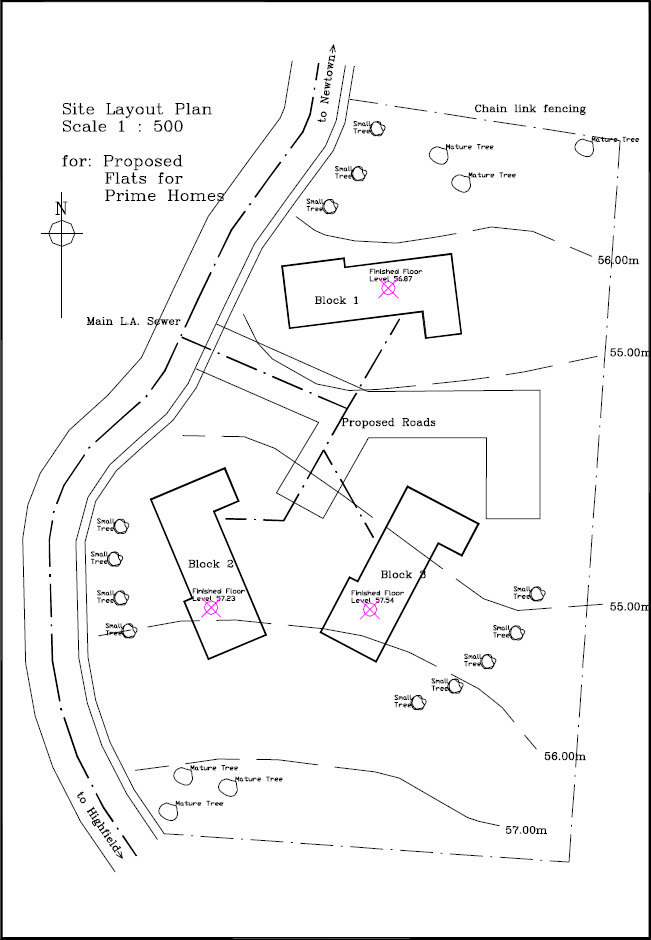Site plan
Contents |
[edit] What is a site plan?
A site plan is typically a large scale drawing that shows the full extent of the site for an existing or proposed development. Site plans, along with location plans, may be necessary for planning applications. In most cases, site plans will be drawn up following a series of desk-based studies and site investigations.
See also: Location plan.
[edit] What scale should a site plan be?
Depending on the size and complexity of the project, site plans are likely to be at a scale of 1:500 or 1:200. However, for very small projects, larger scales may be used, and for large projects smaller scales, or even several drawings may be required, perhaps pulled together on one very small scale plan.
[edit] What should a site plan include?
The information shown on a site plan will vary depending on the nature of the project, however, certain key information is likely to appear on most site plans:
- Title block, giving the project name, drawing type, author, revision number, status, date, the scale used, and so on.
- Notes highlighting changes from previous revisions.
- Directional orientation. This could be a compass or a north-pointing arrow.
- Key dimensions.
- Key materials.
- Site boundaries and delineation of adjacent properties, including where necessary, adjoining or adjacent structures, and surrounding streets.
- The location of the building, buildings or other built assets (such as bridges, tunnels and so on) in relation to their surroundings.
- Trees, tree protection orders, and the main elements of the landscape.
- Parking areas with dimensions or capacities, traffic flows, and signage.
- Roads, footpaths, ramps, paved areas, and so on.
- Easements such as right-of-ways, right of support, and so on.
- Buildings to be demolished or removed.
- The general extent of earthworks, including, cutting and filling, the provision of retaining walls, and so on.
- The general layout of external services, including drainage, water, gas, electricity, telephone, manhole covers, and so on.
- The layout of external lighting.
- Fencing, walls and gates.
- The location of miscellaneous external components such as; bollards, fire hydrants, signage, litter bins, and so on.
Where the site is complex, some of this information might be shown on additional specialist site plans, such as; structural site plans, site history, site lines, services site plans, landscape drawings, access and traffic flows, ground conditions and geology, and so on. Site plans may be accompanied by site sections, showing the topography of the site.
With the adoption of building information modelling (BIM), site plans are likely to form an integral part of the project information model and may be prepared in 3D, perhaps based on a point cloud survey or as light detection and ranging (LIDAR, a combination of the words ‘light’ and ‘radar’).
Site plans might be prepared for both the existing site and the proposed site, and sometimes for intermediate stages if the development is to be phased, or where it is necessary to show information about the phasing of construction works.
See also: Site layout plan for construction.
[edit] Related articles on Designing Buildings
- 3D laser survey.
- As-built drawings and record drawings.
- Block plan.
- Concept drawing.
- Condition survey.
- Development appraisal.
- Elevations.
- Ground conditions.
- Laser scanning.
- Levelling.
- Location plan.
- Pre-construction information.
- Scale drawing.
- Site appraisals.
- Site information.
- Site layout plan for construction.
- Site survey.
- Soil survey.
- Surveyor.
- Types of drawings for building design.
[edit] External references
Featured articles and news
Professional practical experience for Architects in training
The long process to transform the nature of education and professional practical experience in the Architecture profession following recent reports.
A people-first approach to retrofit
Moving away from the destructive paradigm of fabric-first.
International Electrician Day, 10 June 2025
Celebrating the role of electrical engineers from André-Marie Amperè, today and for the future.
New guide for clients launched at Houses of Parliament
'There has never been a more important time for clients to step up and ...ask the right questions'
The impact of recycled slate tiles
Innovation across the decades.
EPC changes for existing buildings
Changes and their context as the new RdSAP methodology comes into use from 15 June.
Skills England publishes Sector skills needs assessments
Priority areas relating to the built environment highlighted and described in brief.
BSRIA HVAC Market Watch - May 2025 Edition
Heat Pump Market Outlook: Policy, Performance & Refrigerant Trends for 2025–2028.
Committing to EDI in construction with CIOB
Built Environment professional bodies deepen commitment to EDI with two new signatories: CIAT and CICES.
Government Grenfell progress report at a glance
Line by line recomendation overview, with links to more details.
An engaging and lively review of his professional life.
Sustainable heating for listed buildings
A problem that needs to be approached intelligently.
50th Golden anniversary ECA Edmundson apprentice award
Deadline for entries has been extended to Friday 27 June, so don't miss out!
CIAT at the London Festival of Architecture
Designing for Everyone: Breaking Barriers in Inclusive Architecture.
Mixed reactions to apprenticeship and skills reform 2025
A 'welcome shift' for some and a 'backwards step' for others.























Comments
[edit] To make a comment about this article, click 'Add a comment' above. Separate your comments from any existing comments by inserting a horizontal line.
Great explanation on what is Site plan.